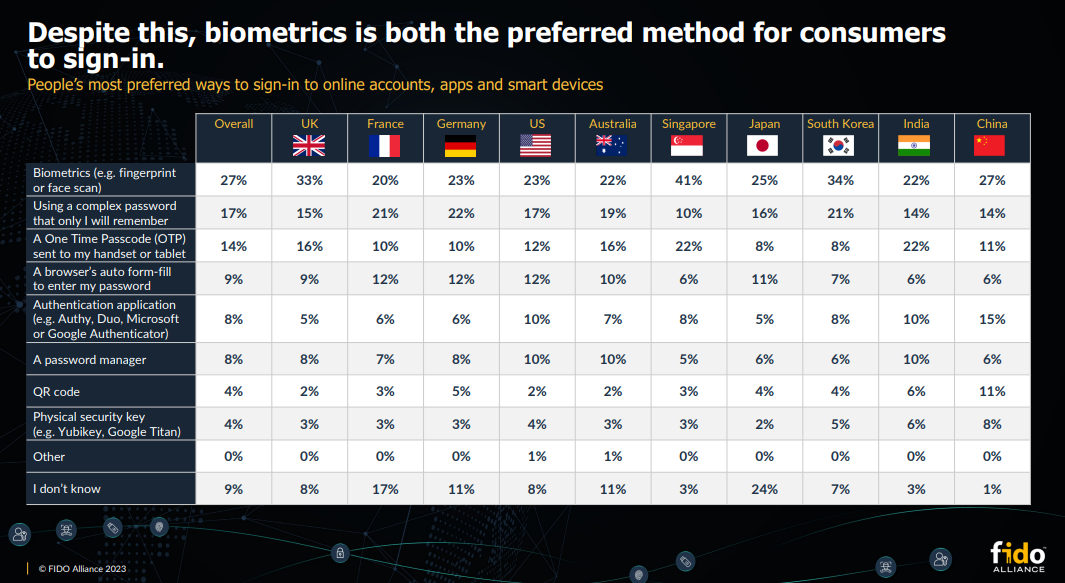In today’s increasingly connected world, the security and sanctity of our digital identities stand at the crossroads.
As countless transactions and interactions shift online, our need for robust and reliable authentication measures has never been more pressing. Within this vast digital landscape, the Asia-Pacific region presents a unique tableau of challenges and innovations.
The FIDO Alliance’s third annual Online Authentication Barometer paints a vivid picture of this landscape, detailing the delicate dance between evolving threats and emerging solutions.
With a particular focus on Singapore, Japan, and India, this article explores key findings from the survey, the rising threat of AI-driven scams, and the increasing adoption of biometric security measures.
An era anchored in passwords
One of the key findings of the FIDO Alliance study is that password usage without two-factor authentication (2FA) remains the dominant authentication method across various use cases. Consumers enter passwords manually approximately four times a day, which amounts to a staggering 1,280 times a year.
This prevalence of passwords as the primary means of authentication is concerning given the increasing sophistication of AI-driven financial scams.
The adoption rates of this manual password entry without 2FA in the past 60 days stand at 30 percent in Singapore, 25 percent in Japan, and 32 percent in India for financial services. Similarly, for work-related accounts, the figures are 38 percent in Singapore, 37 percent in Japan, and 36 percent in India.
Social media usage without 2FA closely mirrors this trend, with Singapore and Japan tied at 28 percent, and India slightly higher at 30 percent.
Beyond fingerprints and retinas
Amid the quagmire of password reliance, the beacon of biometrics shines bright. Users increasingly perceive biometric methods—from fingerprint to facial recognition—as superior alternatives.
The reasons are twofold: an inherent sense of security and a desire for convenience. Singapore’s sentiments are especially telling; 35 percent of its inhabitants view biometrics as the pinnacle of digital safety, and 41 percent prefer it as their go-to authentication tool.
The tide is unmistakably shifting. Year after year, there’s a palpable increase in trust and confidence in biometrics. While passwords remain stubbornly rooted in many scenarios, the steadily expanding footprint of biometric solutions heralds a future where they could become the gold standard for digital authentication.
The rise of hyper-sophisticated scams
The FIDO Alliance survey brings attention to a concerning uptick in online scams. What’s particularly worrying is that these scams are no longer the simple tricks we used to see. Thanks to advancements in artificial intelligence, modern scams have become more sophisticated than ever before.
More than half of the surveyed consumers noticed a significant rise in suspicious online activities, with 52 percent recognizing the heightened complexity of these deceptive efforts.
The intricacies of AI’s role in scams differ between Singapore, Japan and India. A significant 40 percent in Singapore and 30 percent in India attribute fraudulent activities to AI, whereas in Japan, the perception is notably lower at 8 percent.
The proliferation of AI tools like FraudGPT and WormGPT on the darker recesses of the web is a testament to the changing nature of cyber threats, necessitating an agile and adaptive response.
Digital defense and public awareness
Governments aren’t mere spectators in this digital theatre. In the face of rising AI-driven scams, governments and regulatory bodies in the Asia-Pacific region taking steps to protect their citizens.
For instance, Singapore has established the Anti-Scam Command (ASC) to consolidate resources in combatting scams and blocking scam websites, calls, and SMSes. They have also strengthened legislative levers against those facilitating scam activities.
Singapore has also introduced a Shared Responsibility Framework (SRF) for phishing scams, involving financial institutions and telecommunications companies. This framework distributes the responsibility for scam losses among these entities, ultimately benefiting consumers by ensuring compensation when anti-scam duties are breached.
Japan, on the other hand, has enacted stringent laws against unauthorised computer access and revised the Penal Code to impose harsher penalties for cybercrimes. Additionally, Japan has a dedicated agency, the Cybersecurity Strategy Headquarters (CSH), to formulate and implement national cybersecurity policies.
India, too, has responded by indicating that it would regulate AI through the Digital India Act and revising the Information Technology Act in 2022, imposing stricter penalties for cybercrimes involving AI technologies. Initiatives like the Cybercrime Victim Support Portal (CVSP) aim to assist victims of cybercrimes.
Peering into the future
Evolution is the only constant in the realm of digital authentication. While biometrics continue their ascent, passkeys—bolstered by a hefty 58 percent adoption rate—are carving a niche.
Championed by tech behemoths like Apple and Google, passkeys represent a futuristic blend of security and simplicity. This dual advancement, with biometrics on one flank and passkeys on the other, heralds a promising horizon for online authentication.
In synthesizing these findings, the FIDO Alliance Online Authentication Barometer emerges not just as a statistical report but as a roadmap for stakeholders.
AI’s ever-evolving scam arsenal is testing the tenacity of passwords. Concurrently, the rising prominence of biometrics and passkeys offers a glimmer of hope for a safer digital ecosystem. The journey ahead for nations like Singapore, Japan, India, and the broader APAC region is replete with challenges.
Yet, with the right blend of technology, policy, and awareness, there’s hope for a digitally secure future. The clarion call is clear: adapt swiftly or risk being left vulnerable in an unforgiving digital age.
- SEO Powered Content & PR Distribution. Get Amplified Today.
- PlatoData.Network Vertical Generative Ai. Empower Yourself. Access Here.
- PlatoAiStream. Web3 Intelligence. Knowledge Amplified. Access Here.
- PlatoESG. Carbon, CleanTech, Energy, Environment, Solar, Waste Management. Access Here.
- PlatoHealth. Biotech and Clinical Trials Intelligence. Access Here.
- Source: https://fintechnews.sg/79456/security/fido-alliance-singapore-leads-in-biometrics-adoption/








